Summer SAVY 2022/Session 4 – Circuitry, System, and Design for Rising 3rd/4th Grade
Posted by caughem on Monday, July 11, 2022 in blog, SAVY.
Friday: What a powerful final day in our course work! Everything came together for our students to display their learning, presentation styles, as well as support one another with constructive critiques and suggestions for future growth. In small teams, students presented their prepared two-dimensional Electrical Grid Systems Models featuring boundaries, elements, inputs, outputs, and complex interactions within a small city environment. Their electric grid systems had to be of a logical scale and complement their geographic landscapes and features, and had to be representative of carefully planned interactions with other local systems such as transportation, healthcare, communication, economic, educational, industrial, etc. Students defended their work in regard to questions, suggestions, and appreciations, and also received written feedback from peer teams. It was inspiring to see their reasoned explanations and motivations of planning and decision-making processes, and it was equally encouraging to see the attention, focus, and verbal engagement of the audiences in discussions of both concept and detail.
Individual and team considerations were rigorous. What is a system (important because we now know can observe so many)? What generalizations can I observe that are related to sub-systems within an electrical grid or how they are electrical grids interdependent with other systems? What do I need to learn about how electricity “works” in order to design a reliable and safe electrical grid system? How is electricity generated and what are the benefits and drawbacks of the different methods?
Going forward your student may be asking, “What next?” How can I use my new understandings about the science of electricity to consider future projects and endeavors or even careers? What geo-political, social, environmental, or technical understandings do I need to be aware of in relation to energy resource issues? What are the unique aspects of my local energy needs and resources that I should be aware of? What was fascinating this week and compels me to learn more? Where and how can I continue my learning?
Certainly, an ideal answer to the final question is SAVY or VSA! We hope to see you again soon in another intriguing and motivating course on the Vanderbilt campus. Thank you for making this week available for your child. It has been our honor and pleasure!

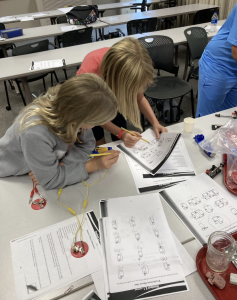

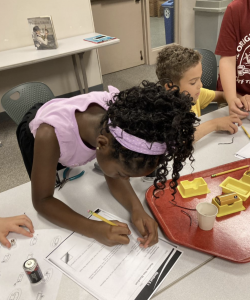
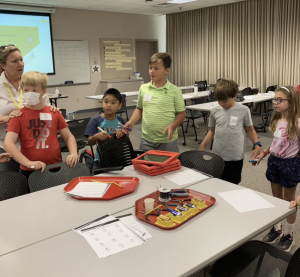
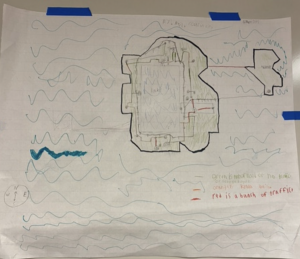

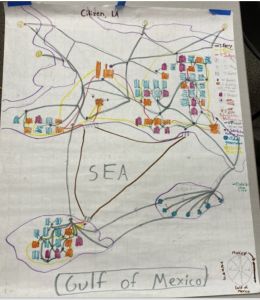


Thursday: Is anyone wondering about the implications of a possible natural disaster to the degree of multiple primary and secondar effects? How can we analyze and plan for addressing complex and multilevel problems? We did today! We remembered the electric grid failures in Texas during the extreme weather in February of 2021. We are thankful for those that keep us powered up with great design planning and reliable responses to emergencies. We are also appreciative of those that work to anticipate challenges and continuously re-design and improve our power grids. How can the concept of redundancy be harnessed? How can we maintain efficiency in our design plans so that our economic systems are not overburdened?
We continue our research at more individual levels in order to continue completion of the team final projects and presentations for tomorrow. We considered the design approaches of Walt Disney World in regard to energy needs and policies of governance. We returned to our planning team to ask many questions. How much energy or power will our city need? Will it be similar to WDW or a city the size of San Francisco? What components need to be considered for our project? How will we communicate our system design elements such as generation, transmission stations and lines, distribution lines, and consumption areas. How have we built in redundancy in case of failure of any of the system elements? What symbols and keys can we utilize for clarity in our presentation? What other systems (transportation, geo-political, etc.) need to be displayed that will interact and be interdependent with our electrical grid system? What new technologies might we consider that are more compatible and reasonable to unique geographical regions (tidal turbine generators)?
We are investigated more about models? How is a model accurate and when can it bring about misconceptions? Are all models true or representative of truth or are they limited in function? Why is this important? How does this thinking impact our models we are creating?
Tomorrow will be such an exciting day to share our knowledge and celebrate all that we have learned and accomplished this week. What an amazing week we have experienced and enjoyed together! No wonder the children’s faces are electric!
Wednesday: We are keeping our eyes on the weather and the NES electrical grid outages maps. We are so thankful that no extreme weather has occurred (although we are always preparing) and that there have not been major outages. We learned more of the impacts of a very historic “blackout” through a 2003 newspaper article from Windsor Star (Ontario), and did further research online. We established a purpose for our research and gathered evidence and data about the problem that impacted more than 50 million people! What were the implications and consequences of this event? What inferences can we make and what concepts and ideas should we follow up on? Our big assumption is that we need to learn more about what happened and how such an event can be prevented again? Who are the stakeholders and what are their points of view that can collaborated in to possible solutions?
In regard to being thankful, we were also much appreciative of the previous contributions and information gathered from (retired) NES Systems Supervisor of Systems Control, Joseph Cauthen. We reviewed transcripts of previous student questions and responses from this expert in the field of Electrical Engineering. We reflected on his journey and talent development strategies in hope of informing our own future paths. Great guidance! Where is electricity for Nashville’s power grid generated? Will we soon be able to “beam” electricity on a large scale, or will we be forever connected to a wire distribution system? What are the considerations for priorities when planning grid designs? Consider this online resource with your child and formulate more questions for independent research! TVA Power Systems We looked specifically at one impressive and unique Tennessee power generation facility in a more technical way, but we wanted to provide you with a more “tourist” version to consider in case you are looking for a family field trip. Mrs. Byrd might see you there one day soon! Must see Raccoon Mountain TVA.
Another fun video you can share with your child has to do with our work to “scale up” interactions at the atomic level in order to gain greater understanding. We’ve acted out or modeled how electrons behave in circuits with both AC and DC currents as well as with resistors. We found some other scholars that are presenting their complex understanding of electron behavior as well through active models! Enjoy! Dance Your PhD! We have worked hard researching and writing about both our new understandings and questions for future study.
Finally, with all our accumulated knowledge, students began to design their own electric grids for a fictitious city approximately the same size (in square miles) as Nashville. What are the major energy users, and do we have an adequate plan for current needs as well as future growth needs? Can we assure our customers that the lights will stay on even when weather or usage patterns become extreme?
Tuesday: So many amazing discussions and discoveries today! I trust your child is furthering their understandings by talking and researching with you at home.
We began by finalizing our new understandings of the scavenger hunt of the classroom from yesterday. We worked to find all the electrical devices built into our space: outlets, switches, lights, technology ports, security, and safety, etc. We will soon observe structural blueprints and industry standards for diagrams and symbols in regard to home electrical wiring as a follow up. How can we use our knowledge of scale and proportion to create drawings and use symbols to observe electrical systems with greater detail and accuracy? We observed a street map of a coastal city to begin thinking about the scale of our culminating project. What should be the scale of our 2D model grid drawings? Can others read and make sense of such symbols and models if they are common or standardized?
For the rest of the morning and in five small group stations, students worked together to find answers to many questions we had recorded in our learning. This was extremely challenging, hands-on work and we were all proud of the efforts and successes! How does electricity work? What materials are conductive and what materials act as an insulator? Who were some of the pioneers that worked with electricity, and how did they experiment to answer their own questions about electric? How are circuits created and organized? What is a parallel circuit? Can I predict from a scale model drawing if a circuit is complete and will be productive in achieving specific results?
We also continued our historical journey by following up our reading of Edison and his expansion of direct current in the northeast with Nikola Tesla’s competing alternating current so spectacularly made famous at the Chicago World’s Fair. We will learn more about power generation and delivery systems on Wednesday. We are also beginning to dig into systems failures with the historical outage in August of 2003 in Ontario, Canada and the Northeast region of American. We will continue our questioning. How did this system function before the outage and what went wrong? How can this be prevented in current or future grid designs? When addressing access to services, how can we determine equity? What are the issues and concerns for different stakeholders?
We are looking forward to seeing everyone tomorrow!
Monday: Thank you so much for making this opportunity available for your child! The level of engagement and enthusiasm was ELECTRIC! I truly look forward to all that we can learn and accomplish this week in July’s Session 4 of SAVY.
What is a system? In observing many systems (refrigeration systems, educational systems, transportation systems, political/governmental systems), etc.) we observed that systems include boundaries, elements, inputs, outputs, and interactions. Systems are everywhere!
Today the young engineers and designers experienced what a natural disaster can do to your planning! Right in the middle of the new hire orientation scenario at the local power company, we have power outages in eight states! It’s all hands on deck! Our design project for a recreational facility is on hold for now in order to assist linemen and grid workers get things back in order in the midst of hurricane and tornado damage! What do we know? What do we need to know, and how can we find out? The lists of questions are long. How can we use our new understanding of systems to solve these real-world problems in the crisis? We know systems can be interdependent, so what other systems are in critical need if the power grid is dysfunctional? What subsystems do we count on to solve the power disruption? What do we know about electricity that we should keep in mind as we plan to work in adverse conditions? Are there other problems that must be discovered before we plan? Break out the maps and grids, and let’s take a look at this as a team!
How do maps work and what is scale? To think more about these two-dimensional models, we observed the scale of an actual 1:27 scale Ford F-150 Raptor pickup truck. We even considered the ratio of frogs that can jump 50 times their length! What if Mrs. Byrd could jump like a frog (1:50) or 50 times her height? Finally, we will map out our classroom space to scale and begin using symbols for mapping the electrical wiring. Can you help your child with a scale drawing of a room in your home? What are the electrical needs of this room?
Safety became a major part of our conversations. Our class discussions revealed our lack of knowledge and a need to research and respect the power of electricity. We are not able to engage in activities or experiments without adult supervision and when disaster strikes, we must take precautions. Check out this website with your child to discuss at home electrical safety:
NES Safety








